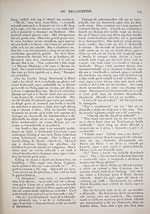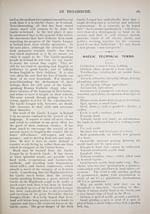Blair Collection > Deo-gréine
(204)
Download files
Complete book:
Individual page:
Thumbnail gallery: Grid view | List view

t8o
AN DEO-GHREINE.
gath fann soluis astar air thoiseach oirnn. Air
an t -solus a ruigheachd, chuanaic sinn gu'n
d' thàinig e a seomar soillseach a bha ris an
deas. Bha trannsa goirid a' treòrachadh g'a
ionnsuidh. Bha sreath de choibhan snaidhte
air gach taobh de'n trannsa, Ie bogha cloiche
tarsuing eadar gach paidhir. Bha na bogh-
achan so greadhnaichte lemireangloinne ioma-
shlisneach, agus de ioma dath, mar an uinn-
eagan Eaglais-Mhòir Ghlascho ; agus bha
maise air a thilgeadh air gach ni tre dhealradh
an t-soluis trompa. Chaidh sinn air adhart
do'n dorus. Bha'n seomar air a chladhach as
a' charraig, a bha'n so oho geal ri marmor fior-
ghlan.agus a'dearrsadh fosholus ceud coinneal
bheag chèir, a bh' an coinnlear mòr, an croch-
adh bho'n mhullach. Am meadhon an t-seòm-
air bha coslas altair ceithir-oisnich, de'n aon
seòrsa cloiche ris a' chuid eile. 'Na shuidhe
air bha crùn na h-Austria, has an dà litir, F.I.
mu throidh air fad. os ceann a' chrùin air son
Fraing loseph, lompaire na h-Austria. Bha'n
crun agus na litricliean air an grinneachadh
lr seudan dealrach, mar anns an fhìor chrùn.
Ciod an t-iongantas a chuir e oirnn an uair a
chaidh innseadh dhuinn gu'm b' ami de
chlachan salainn a bha na seudan uile, agus
na mìrean gloinne òirdheirc air an gearradh.
Bha iad an sin de dhearg, de phurpur, de uaine,
de ghorm agus de bhuidhe ; am feadh a bha'n
seòmar, bho ùrlar gu mullach, geal mar an
sneachd.
GAELIC REVIVAL IN IRELAND.
By Major E. D. C. Cameron.
The recent revival of Gaelic in Ireland is un-
doubtedly one of the most remarkable move-
ments of modern times. Fifteen years ago
< i ; i < ■ I i < in Ireland had readied a very low ebb
indeed. The language had opposed toil no1
only the English-speaking people of Ireland ;
but also the Gaelic-speaking peasantry them-
selves. Irish Gaelic had come to be looked
upon by th< people themselves as the hall-
mark of ignorance, and in itself a nuisance
and an obstacle to material progress and to
i nlighte -ni . 'i he Irish people were then
of their own accord giving up their ances-
tral tongue as quickly as possible. 'I hey were
at special pains to prevenl their children from
speaking ( iaelic. In fad ai the time thai the
( iaelic League was founded, the case of Gaelic
in Ireland appeared to lie absolutely hopeless,
and its eventual death seemed 1 1 be merel) a
question of time.
The Gaelic League had, therefore, what
appeared to be humanly speaking an absol-
utely impossible task ro restore the language
t< > a people among whom it had fallen into such
disrepute. The amount of success that they
have already achieved is nothing short of
the marvellous. They have succeeded in re-
instating the language in the favour of the
Irish people generally, at anyrate among those
w In > are mainly of (iaelic descent. The efforts
of the ( 'iaelic League have been directed with
great persistence towards the general introduc-
tion of efficient teaching of (iaelic in the
Schools. These efforts have been unquestion-
ably rewarded with marked success. The
Irish children generally are willing and keen
to learn (iaelic. which is taught in something
like three thousand schools throughout the
country. It is a significant fact that the
excellent and efficient Christian Brother
Schools which are not under government con-
trol teach all their children Gaelic. As
regards the National Schools which were at
one time regarded as one of the chief causes
of the destruction of the Gaelic language in
Ireland, it is not too much to say that they
have now become one of the chief instruments
of its restoration. The Gaelic League may
justly claim a triumph in this matter.
Another significant fact is the attitude of
the Roman Catholic Church (which includes
nearly all the Irish people of Gaelic descent).
At their annual meeting last year, the Roman
Catholic Hierarchy passed a resolution in
which they earnestly exhorted their school
managers to have their teachers trained for
the teaching of ( iaelic, and to see that it is
taught in their schools. All the students at
Mavnooih College hit now being taught
(iaelic, so that in a few years all the younger
Roman Catholic priests will have some know-
ledge of ( iaelic.
The (iaelic League have also made vigorous
efforts for the teaching of (iaelic to those who
have left school. Many of these classes are
largeh attended and the self-denying exertions
of the many earnest men and women who
teach them are greatly to be commended. In
the matter of grammars and other elementary
books for the teaching of Gaelic, Ireland is
far before Scotland.
What perhaps strikes a visitor to Ireland
more than anything else is the business-like
manner in which the affairs of the Gaelic
League are carried on, and the thoroughness
with which it does its work. In the past,
Celtic efforts have loo often been of a spas-
modic nature and have not been carried out
on business-like lines. The (iaelic movement
in Ireland is an exception to this general rule.
I he fullest possible use of the 'language is
made by the officials who conduct the affairs
of the league in (iaelic both orally and in
writing. At the classes, (iaelic is much more
AN DEO-GHREINE.
gath fann soluis astar air thoiseach oirnn. Air
an t -solus a ruigheachd, chuanaic sinn gu'n
d' thàinig e a seomar soillseach a bha ris an
deas. Bha trannsa goirid a' treòrachadh g'a
ionnsuidh. Bha sreath de choibhan snaidhte
air gach taobh de'n trannsa, Ie bogha cloiche
tarsuing eadar gach paidhir. Bha na bogh-
achan so greadhnaichte lemireangloinne ioma-
shlisneach, agus de ioma dath, mar an uinn-
eagan Eaglais-Mhòir Ghlascho ; agus bha
maise air a thilgeadh air gach ni tre dhealradh
an t-soluis trompa. Chaidh sinn air adhart
do'n dorus. Bha'n seomar air a chladhach as
a' charraig, a bha'n so oho geal ri marmor fior-
ghlan.agus a'dearrsadh fosholus ceud coinneal
bheag chèir, a bh' an coinnlear mòr, an croch-
adh bho'n mhullach. Am meadhon an t-seòm-
air bha coslas altair ceithir-oisnich, de'n aon
seòrsa cloiche ris a' chuid eile. 'Na shuidhe
air bha crùn na h-Austria, has an dà litir, F.I.
mu throidh air fad. os ceann a' chrùin air son
Fraing loseph, lompaire na h-Austria. Bha'n
crun agus na litricliean air an grinneachadh
lr seudan dealrach, mar anns an fhìor chrùn.
Ciod an t-iongantas a chuir e oirnn an uair a
chaidh innseadh dhuinn gu'm b' ami de
chlachan salainn a bha na seudan uile, agus
na mìrean gloinne òirdheirc air an gearradh.
Bha iad an sin de dhearg, de phurpur, de uaine,
de ghorm agus de bhuidhe ; am feadh a bha'n
seòmar, bho ùrlar gu mullach, geal mar an
sneachd.
GAELIC REVIVAL IN IRELAND.
By Major E. D. C. Cameron.
The recent revival of Gaelic in Ireland is un-
doubtedly one of the most remarkable move-
ments of modern times. Fifteen years ago
< i ; i < ■ I i < in Ireland had readied a very low ebb
indeed. The language had opposed toil no1
only the English-speaking people of Ireland ;
but also the Gaelic-speaking peasantry them-
selves. Irish Gaelic had come to be looked
upon by th< people themselves as the hall-
mark of ignorance, and in itself a nuisance
and an obstacle to material progress and to
i nlighte -ni . 'i he Irish people were then
of their own accord giving up their ances-
tral tongue as quickly as possible. 'I hey were
at special pains to prevenl their children from
speaking ( iaelic. In fad ai the time thai the
( iaelic League was founded, the case of Gaelic
in Ireland appeared to lie absolutely hopeless,
and its eventual death seemed 1 1 be merel) a
question of time.
The Gaelic League had, therefore, what
appeared to be humanly speaking an absol-
utely impossible task ro restore the language
t< > a people among whom it had fallen into such
disrepute. The amount of success that they
have already achieved is nothing short of
the marvellous. They have succeeded in re-
instating the language in the favour of the
Irish people generally, at anyrate among those
w In > are mainly of (iaelic descent. The efforts
of the ( 'iaelic League have been directed with
great persistence towards the general introduc-
tion of efficient teaching of (iaelic in the
Schools. These efforts have been unquestion-
ably rewarded with marked success. The
Irish children generally are willing and keen
to learn (iaelic. which is taught in something
like three thousand schools throughout the
country. It is a significant fact that the
excellent and efficient Christian Brother
Schools which are not under government con-
trol teach all their children Gaelic. As
regards the National Schools which were at
one time regarded as one of the chief causes
of the destruction of the Gaelic language in
Ireland, it is not too much to say that they
have now become one of the chief instruments
of its restoration. The Gaelic League may
justly claim a triumph in this matter.
Another significant fact is the attitude of
the Roman Catholic Church (which includes
nearly all the Irish people of Gaelic descent).
At their annual meeting last year, the Roman
Catholic Hierarchy passed a resolution in
which they earnestly exhorted their school
managers to have their teachers trained for
the teaching of ( iaelic, and to see that it is
taught in their schools. All the students at
Mavnooih College hit now being taught
(iaelic, so that in a few years all the younger
Roman Catholic priests will have some know-
ledge of ( iaelic.
The (iaelic League have also made vigorous
efforts for the teaching of (iaelic to those who
have left school. Many of these classes are
largeh attended and the self-denying exertions
of the many earnest men and women who
teach them are greatly to be commended. In
the matter of grammars and other elementary
books for the teaching of Gaelic, Ireland is
far before Scotland.
What perhaps strikes a visitor to Ireland
more than anything else is the business-like
manner in which the affairs of the Gaelic
League are carried on, and the thoroughness
with which it does its work. In the past,
Celtic efforts have loo often been of a spas-
modic nature and have not been carried out
on business-like lines. The (iaelic movement
in Ireland is an exception to this general rule.
I he fullest possible use of the 'language is
made by the officials who conduct the affairs
of the league in (iaelic both orally and in
writing. At the classes, (iaelic is much more
Set display mode to: Large image | Transcription
Images and transcriptions on this page, including medium image downloads, may be used under the Creative Commons Attribution 4.0 International Licence unless otherwise stated. ![]()
| Early Gaelic Book Collections > Blair Collection > Deo-gréine > (204) |
|---|
| Permanent URL | https://digital.nls.uk/76699937 |
|---|
| Description | A selection of books from a collection of more than 500 titles, mostly on religious and literary topics. Also includes some material dealing with other Celtic languages and societies. Collection created towards the end of the 19th century by Lady Evelyn Stewart Murray. |
|---|
| Description | Selected items from five 'Special and Named Printed Collections'. Includes books in Gaelic and other Celtic languages, works about the Gaels, their languages, literature, culture and history. |
|---|

